A Performance-Enhanced Liquid Metal-Based Microheater with Parallel Ventilating Side-Channels
Abstract
1. Introduction
2. Experiments and Methods
3. Experimental Principle and Setup
4. Results and Discussion
4.1. Experimental Results
4.2. Analysis and Discussion
4.3. Mechanical Tests
4.4. Heating Application
5. Conclusions
6. Experimental Section
6.1. Synthesis of liquid PDMS
6.2. Preparation of Eutectic Alloy Ga75.5In24.5
Supplementary Materials
Author Contributions
Funding
Conflicts of Interest
References
- Heikenfeld, J.; Jajack, A.; Rogers, J.; Gutruf, P.; Tian, L.; Pan, T.; Li, R.; Khine, M.; Wang, J.; Kim, J.; et al. Wearable sensors: Modalities, challenges, and prospects. Lab Chip 2018, 18, 217–248. [Google Scholar] [CrossRef]
- Xu, S.; Zhang, Y.; Jia, L.; Mathewson, K.E.; Jang, K.I.; Kim, J.; Fu, H.; Huang, X.; Chava, P.; Wang, R.; et al. Soft Microfluidic Assemblies of Sensors, Circuits, and Radios for the Skin. Science 2014, 344, 70–74. [Google Scholar] [CrossRef] [PubMed]
- Duncanson, W.J.; Lin, T.; Abate, A.R.; Seiffert, S.; Shah, R.K.; Weitz, D.A. Microfluidic synthesis of advanced microparticles for encapsulation and controlled release. Lab Chip 2012, 12, 2135–2145. [Google Scholar] [CrossRef] [PubMed]
- Wang, Q.; Yü, Y.; Yang, J.; Liu, J. Fast Fabrication of Flexible Functional Circuits Based on Liquid Metal Dual-Trans Printing. Adv. Mater. 2015, 27, 7109–7116. [Google Scholar] [CrossRef]
- Morley, N.B.; Burris, J.; Cadwallader, L.C.; Nornberg, M.D. GaInSn usage in the research laboratory. Rev. Sci. Instrum. 2008, 79, 056107. [Google Scholar] [CrossRef] [PubMed]
- Ladd, C.; So, J.H.; Muth, J.; Dickey, M.D. 3D Printing of Free Standing Liquid Metal Microstructures. Adv. Mater. 2013, 25, 5081–5085. [Google Scholar] [CrossRef] [PubMed]
- Blaiszik, B.J.; Kramer, S.L.; Grady, M.E.; McIlroy, D.A.; Moore, J.S.; Sottos, N.R.; White, S.R. Autonomic restoration of electrical conductivity. Adv. Mater. 2012, 24, 398–401. [Google Scholar] [CrossRef]
- Cheng, S.; Wu, Z. A Microfluidic, Reversibly Stretchable, Large-Area Wireless Strain Sensor. Adv. Funct. Mater. 2011, 21, 2282–2290. [Google Scholar] [CrossRef]
- Varga, M.; Mehmann, A.; Marjanovic, J.; Reber, J.; Vogt, C.; Pruessmann, K.P.; Tröster, G. Adsorbed Eutectic GaIn Structures on a Neoprene Foam for Stretchable MRI Coils. Adv. Mater. 2017, 29, 1703744. [Google Scholar] [CrossRef]
- Gao, M.; Gui, L.; Liu, J. Study of Liquid-Metal Based Heating Method for Temperature Gradient Focusing Purpose. J. Heat Transf. 2013, 135, 091402. [Google Scholar] [CrossRef]
- Unger, M.A. Monolithic Microfabricated Valves and Pumps by Multilayer Soft Lithography. Science 2000, 288, 113–116. [Google Scholar] [CrossRef] [PubMed]
- Qi, H.; Chen, T.; Yao, L.; Zuo, T. Micromachining of microchannel on the polycarbonate substrate with CO2 laser direct-writing ablation. Opt. Lasers Eng. 2009, 47, 594–598. [Google Scholar] [CrossRef]
- Bhattacharjee, N.; Urrios, A.; Kang, S.; Folch, A. The upcoming 3D-printing revolution in microfluidics. Lab Chip 2016, 16, 1720–1742. [Google Scholar] [CrossRef] [PubMed]
- Sun, J.; Gong, L.; Lu, Y.; Wang, N.; Gong, Z.; Fan, M. Dual functional PDMS sponge SERS substrate for the on-site detection of pesticides both on fruit surfaces and in juice. Analyst 2018, 143, 2689–2695. [Google Scholar] [CrossRef]
- Lagally, E.T.; Emrich, C.A.; Mathies, R.A. Fully integrated PCR-capillary electrophoresis microsystem for DNA analysis. Lab Chip 2001, 1, 102–107. [Google Scholar] [CrossRef]
- Sukjoon, H.; Junyeob, Y.; Gunho, K.; Dongkyu, K.; Habeom, L.; Jinhyeong, K.; Hyungman, L.; Phillip, L.; Seung Hwan, K. Nonvacuum, maskless fabrication of a flexible metal grid transparent conductor by low-temperature selective laser sintering of nanoparticle ink. ACS Nano 2013, 7, 5024–5031. [Google Scholar]
- Siegel, A.C.; Tang, S.K.Y.; Nijhuis, C.A.; Hashimoto, M.; Phillips, S.T.; Dickey, M.D.; Whitesides, G.M. Cofabrication: A Strategy for Building Multicomponent Microsystems. Acc. Chem. Res. 2010, 43, 518–528. [Google Scholar] [CrossRef]
- Je, J.; Lee, J. Design, Fabrication, and Characterization of Liquid Metal Microheaters. J. Microelectromech. Syst. 2014, 23, 1156–1163. [Google Scholar]
- Ma, R.; Guo, C.; Zhou, Y.; Liu, J. Electromigration Induced Break-up Phenomena in Liquid Metal Printed Thin Films. J. Electron. Mater. 2014, 43, 4255–4261. [Google Scholar] [CrossRef]
- Michaud, H.O.; Lacour, S.P. Liquid electromigration in gallium-based biphasic thin films. APL Mater. 2019, 7, 031504. [Google Scholar] [CrossRef]
- So, J.H.; Dickey, M.D. Inherently aligned microfluidic electrodes composed of liquid metal. Lab Chip 2011, 11, 905–911. [Google Scholar] [CrossRef] [PubMed]
- Pircheraghi, G.; Powell, T.; Bonab, V.S.; Manas-Zloczower, I. Effect of carbon nanotube dispersion and network formation on thermal conductivity of thermoplastic polyurethane/carbon nanotube nanocomposites. Polym. Eng. Sci. 2016, 56, 394–407. [Google Scholar] [CrossRef]
- Dickey, M.D.; Chiechi, R.C.; Larsen, R.J.; Weiss, E.A.; Weitz, D.A.; Whitesides, G.M. Eutectic Gallium-Indium (EGaIn): A Liquid Metal Alloy for the Formation of Stable Structures in Microchannels at Room Temperature. Adv. Funct. Mater. 2008, 18, 1097–1104. [Google Scholar] [CrossRef]
- Hu, H.; Shaikh, K.; Liu, C. Super flexible sensor skin using liquid metal as interconnect. In Proceedings of the Sensors, Atlanta, GA, USA, 28–31 October 2007. [Google Scholar]
- Lamberti, A.; Marasso, S.L.; Cocuzza, M. PDMS membranes with tunable gas permeability for microfluidic applications. RSC Adv. 2014, 4, 61415–61419. [Google Scholar] [CrossRef]
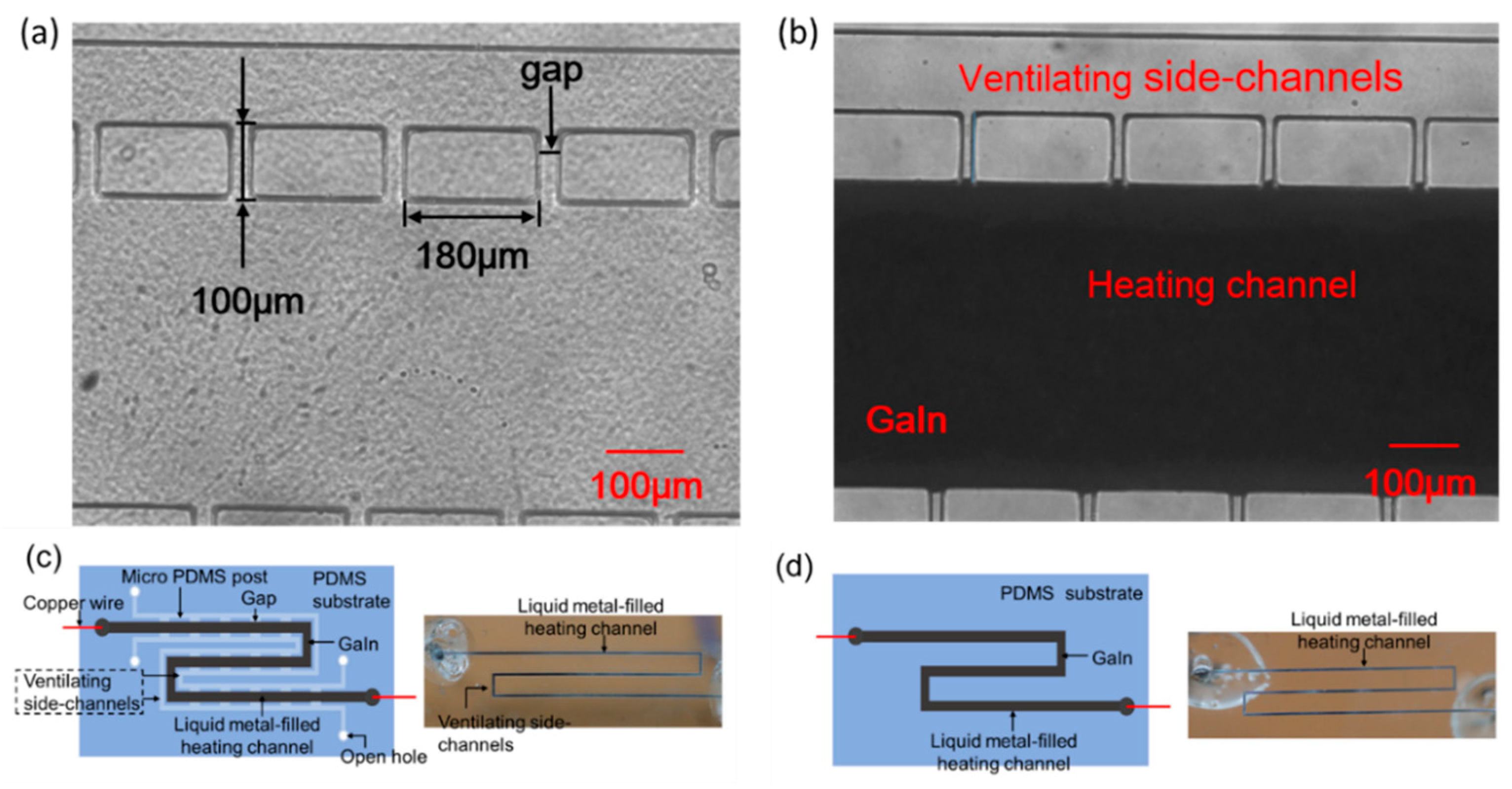
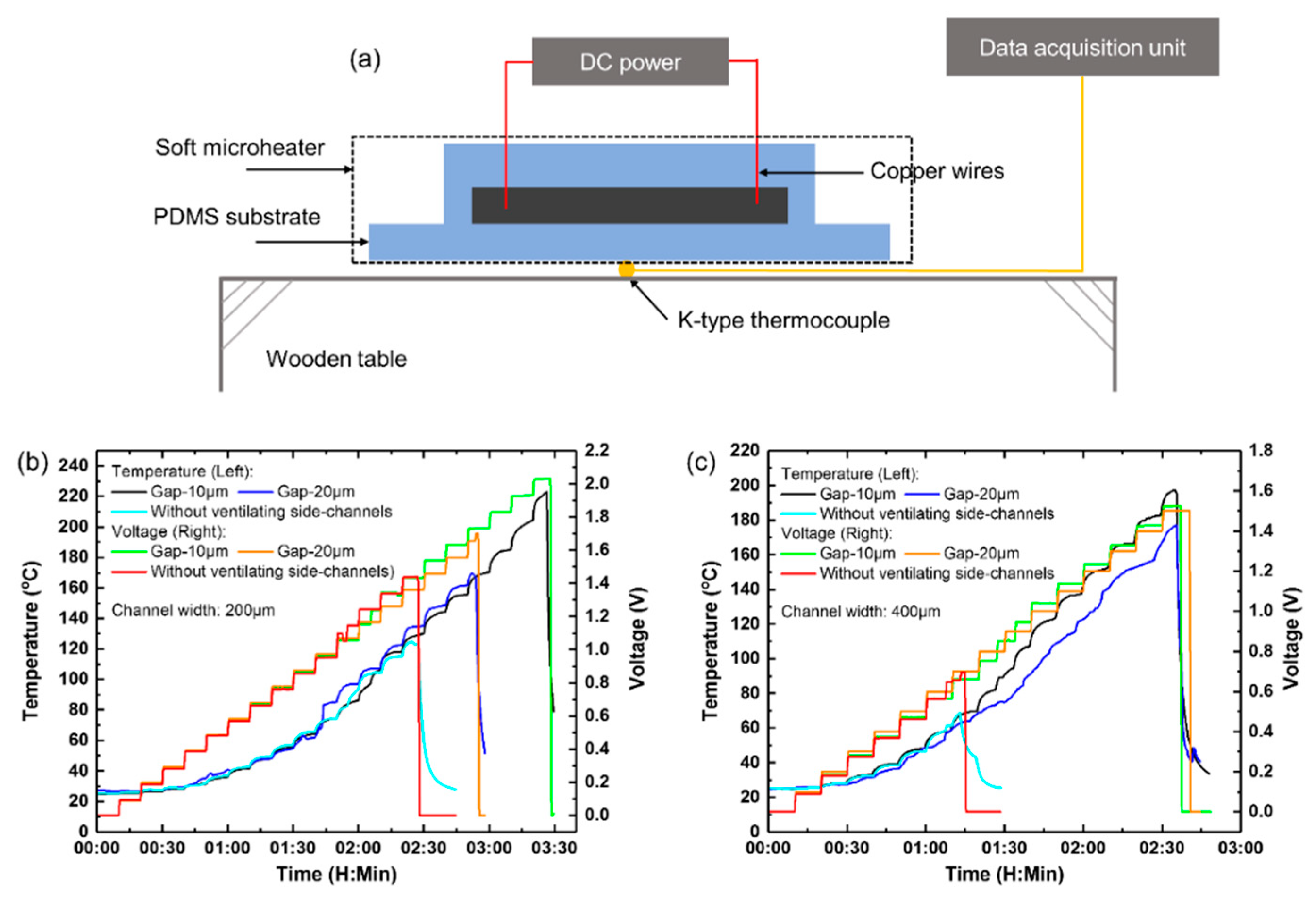
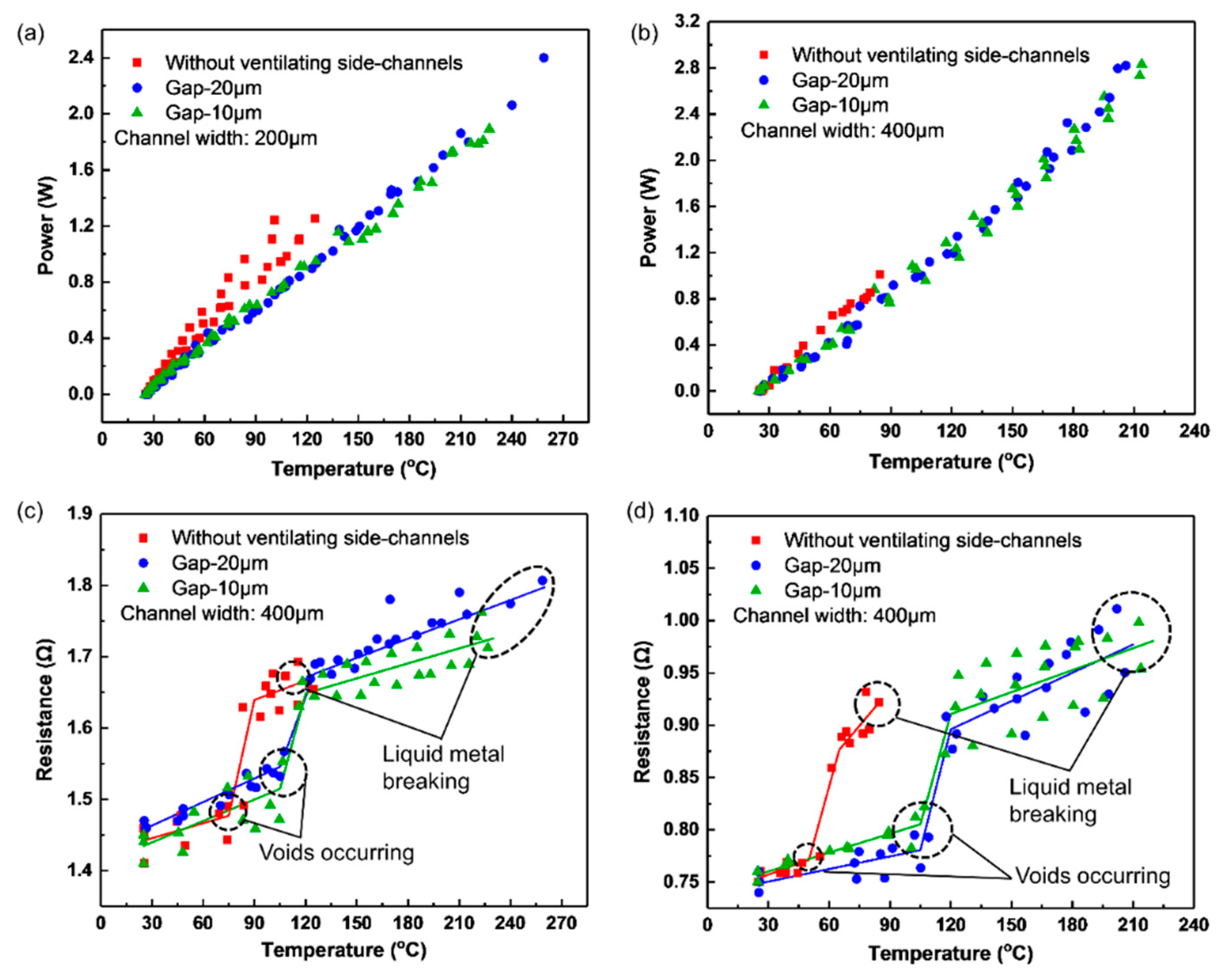
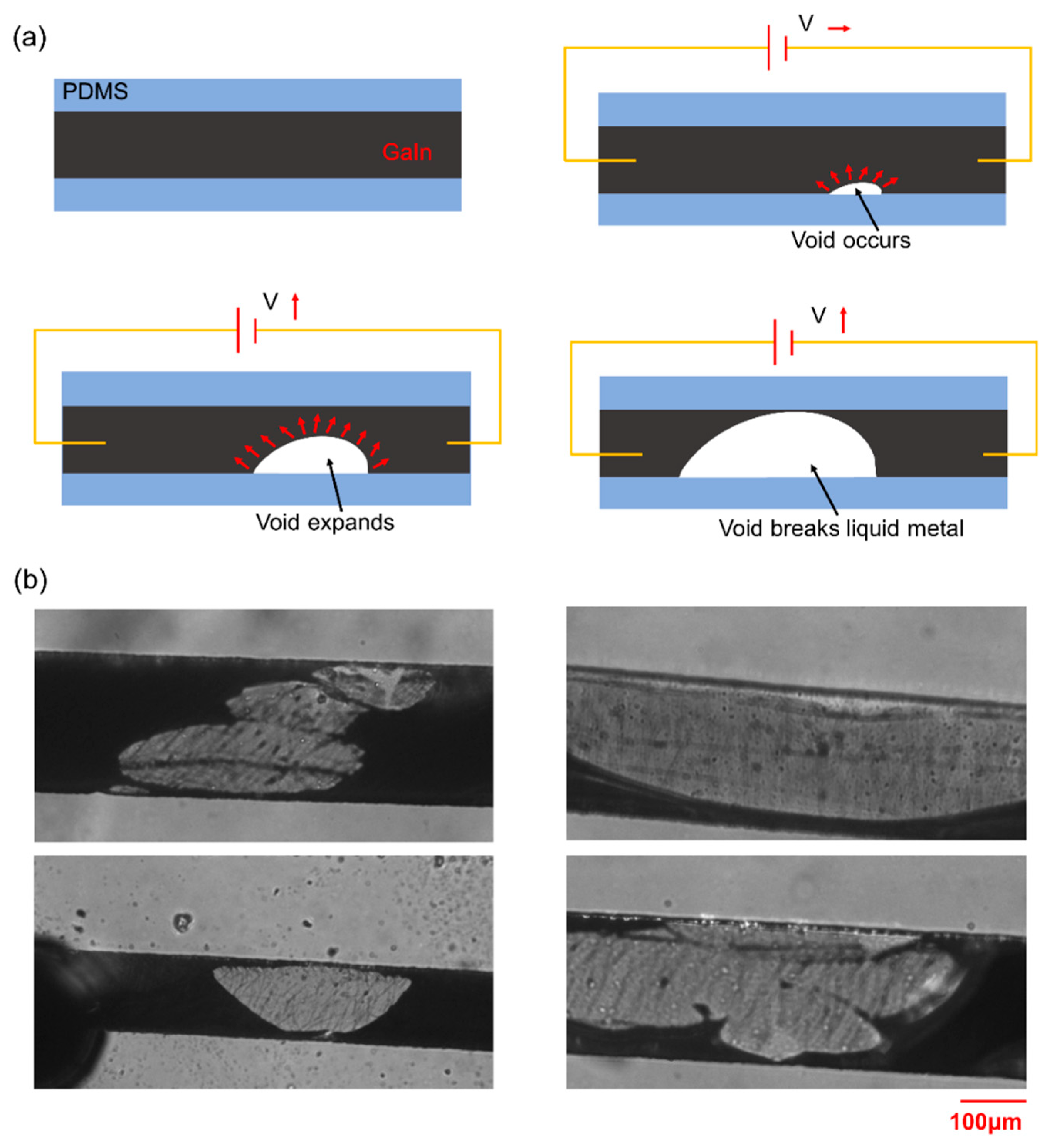
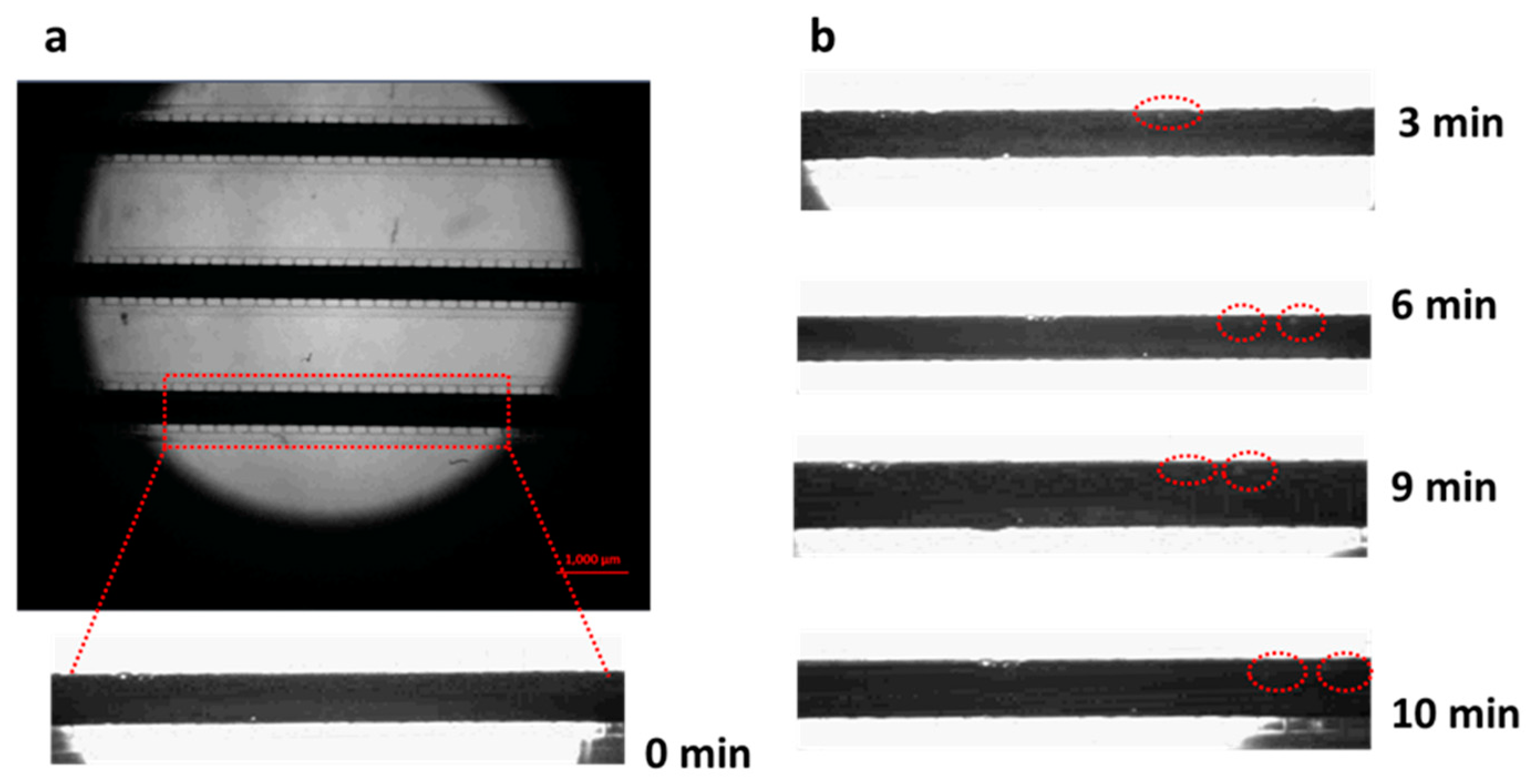
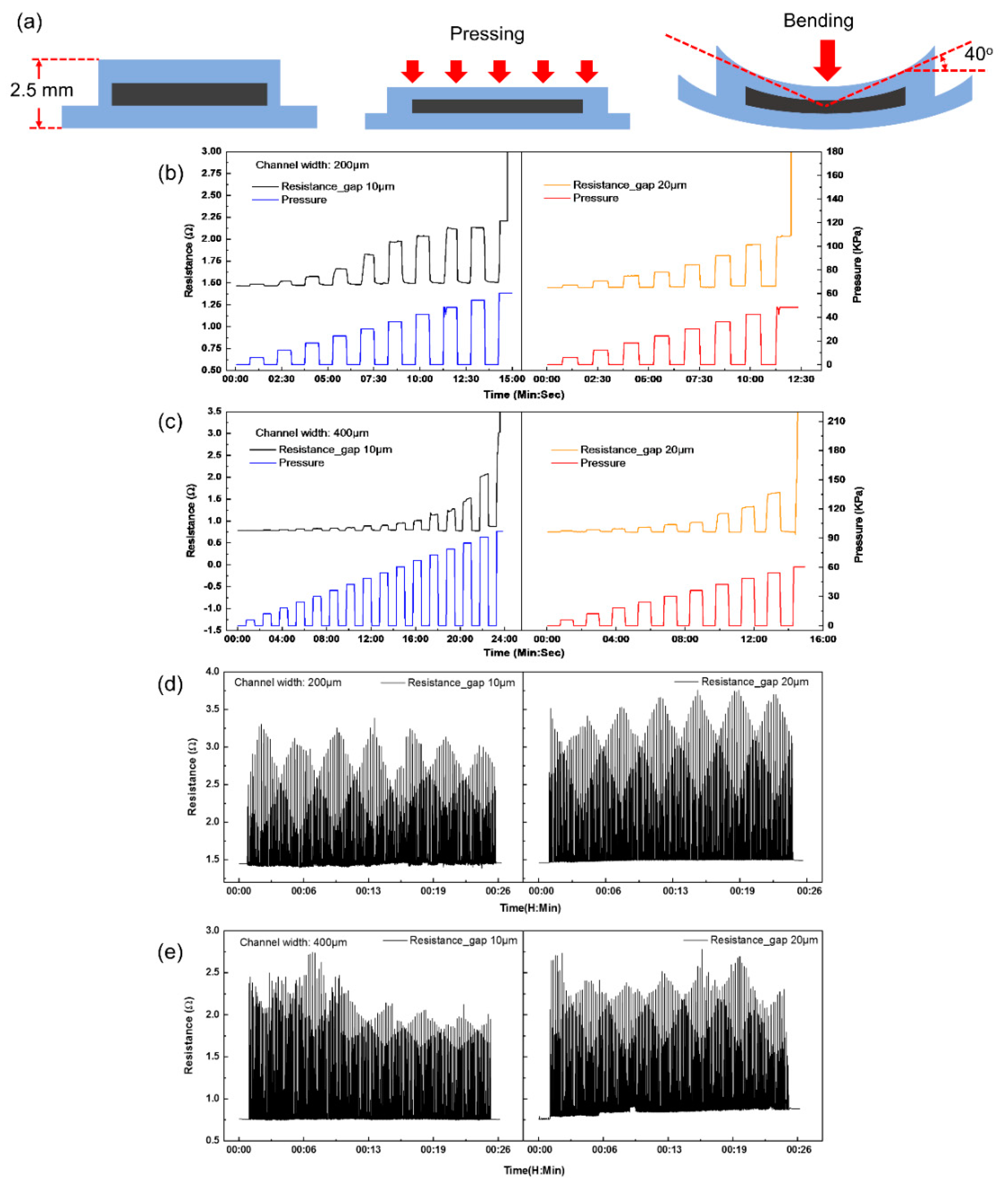


| Parameters | With Ventilating Side-Channels | Without Ventilating Side-Channels | ||||
|---|---|---|---|---|---|---|
| Width of liquid metal channel (μm) | 200 | 200 | 400 | 400 | 200 | 400 |
| Height of liquid metal channel (μm) | 80 | 80 | 80 | 80 | 80 | 80 |
| Length of liquid metal channel (cm) | 6 | 6 | 6 | 6 | 6 | 6 |
| Gap between PDMS posts (μm) | 10 | 20 | 10 | 20 | N/A | N/A |
| Width of ventilating side-channels | 200 | 200 | 100 | 100 | N/A | N/A |
| Initial resistance (Ω) | 1.45 | 1.46 | 0.76 | 0.76 | 1.41 | 0.75 |
| Width of Heating Channels (μm) | Cap between Post (μm) | Critical Temperature (°C) | Highest Temperature (°C) | Corresponding Power (w) |
|---|---|---|---|---|
| 200 | 10 20 No post | −105 −105 −75 | 223.40 212.80 113.70 | 1.89 2.40 1.25 |
| 400 | 10 | −105 | 207.9 | 2.83 |
| 20 No post | −105 −50 | 195.00 77.18 | 2.82 1.01 |
© 2020 by the authors. Licensee MDPI, Basel, Switzerland. This article is an open access article distributed under the terms and conditions of the Creative Commons Attribution (CC BY) license (http://creativecommons.org/licenses/by/4.0/).
Share and Cite
Zhang, L.; Zhang, P.; Wang, R.; Zhang, R.; Li, Z.; Liu, W.; Wang, Q.; Gao, M.; Gui, L. A Performance-Enhanced Liquid Metal-Based Microheater with Parallel Ventilating Side-Channels. Micromachines 2020, 11, 133. https://doi.org/10.3390/mi11020133
Zhang L, Zhang P, Wang R, Zhang R, Li Z, Liu W, Wang Q, Gao M, Gui L. A Performance-Enhanced Liquid Metal-Based Microheater with Parallel Ventilating Side-Channels. Micromachines. 2020; 11(2):133. https://doi.org/10.3390/mi11020133
Chicago/Turabian StyleZhang, Lunjia, Pan Zhang, Ronghang Wang, Renchang Zhang, Zhenming Li, Wei Liu, Qifu Wang, Meng Gao, and Lin Gui. 2020. "A Performance-Enhanced Liquid Metal-Based Microheater with Parallel Ventilating Side-Channels" Micromachines 11, no. 2: 133. https://doi.org/10.3390/mi11020133
APA StyleZhang, L., Zhang, P., Wang, R., Zhang, R., Li, Z., Liu, W., Wang, Q., Gao, M., & Gui, L. (2020). A Performance-Enhanced Liquid Metal-Based Microheater with Parallel Ventilating Side-Channels. Micromachines, 11(2), 133. https://doi.org/10.3390/mi11020133






